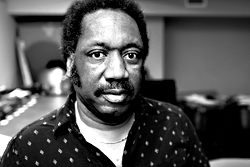Michael Crusoe is all set for the Seattle Symphony’s morning rehearsal of Prokofiev’s Fifth Symphony. His four copper timpani are tuned and ready, arrayed on his 7-foot-square platform at the rear of Benaroya Hall’s stage, next to the basses, behind the harp, under the looming wooden pipes of the hall’s organ.
But first, Crusoe waits. Winds and low strings play the slowly uncurling, upwardly striving main theme, and gradually the rest of the orchestra enters. Except for him. Then just a few notes, boom, boom, played with the tuba and basses. Crusoe bends over his drums to check the tuning—just a flick of the fingertip on the skins, inaudible to anyone else, is all he needs to hear their pitches, which he adjusts with the pedals. Then he waits.
At the front of the stage, the violas and cellos are churning their hearts out and the violins are soaring. And the Seattle Symphony’s timpanist for nearly 30 years continues to wait.
Timpani players don’t have a lot to do, but what they do almost always has an impact—adding mystery and ominousness in quiet moments and overwhelming thunder in loud ones. Of all orchestral instruments, timpani cover the widest dynamic range, and Crusoe makes the most of every sound, playing even Prokofiev’s subtlest notes with a snap and flourish. It’s the timpanist’s peculiar role in an orchestra, and Crusoe’s virtuosic mastery of it, that’s made him one of the most visible and popular SSO players, regularly earning fervent cheers during his solo bows. When he plays, he’s at once self-effacing and a showman: It’s not about him, but about his contribution—as vivid and powerful as he can make it—to the whole.
For long waits, as in Prokofiev’s slow movement, Crusoe has a stool at the rear of his platform. Next to it, on a black chair, rests his suitcase full of drumsticks. For this rehearsal, he’s chosen a pair with deep reddish-brown handles and snow-white felt heads. In his rehearsal room backstage, Crusoe keeps 17 more drums; one set of four belongs to the SSO, the rest are his. The most I’ve seen him use at once is eight—ranged around him in a full 360 circle—while performing a timpani concerto a few years back.
Conductor Gerard Schwarz runs through the whole symphony without stopping, then decides to rehearse a few passages in more detail. Back to the first movement—and Crusoe retunes his drums. The orchestra polishes a few bars, and Schwarz jumps to another section of the symphony—”Let’s start at number 6.” This passage requires yet a different set of pitches from Crusoe, who bends to the skins once more as he adjusts the pedals. It had never occurred to me that when a conductor spot-checks a piece—eight bars here, six there—the timpani may need to retune every minute. But Crusoe, of course, is used to this, and unflappably patient, exchanging glances, smiles, and wisecracks with the players around him. (Contrary to myth, an orchestra does not consist of 80 robots staring blankly at the podium.)
Crusoe, 57, has been with the SSO since September 1980, when he was hired by Rainer Miedel, Schwarz’s predecessor. His earlier ambition was to teach, and he earned a music-education degree from the University of Missouri campus in his hometown of St. Louis. But he never felt good enough to consider percussion performance as a career—until the time, as a student, he filled in on one day’s notice in a St. Louis Youth Symphony concert. It’s an oft-told story, but a good one: Some time later, Crusoe heard an orchestra on his car radio and was impressed by the timpanist’s skill. He assumed it was a recording—until at the end the DJ announced it was a tape of that Youth Symphony concert, and the impressive timpanist was himself. That convinced him to give it a go: “So I hit the audition circuit.” But not for long: The SSO job he won was the third audition of his career.
Crusoe hasn’t stopped teaching, though, at Seattle public schools, Seattle University, and UW, and in various master classes and workshops. As the chair of the SSO’s orchestra committee, an elected post, he also serves as union steward, overseeing the contract on the players’ behalf and representing them to management. (The current contract, due to expire Aug. 31, was recently extended through the end of the year.)
He finds working with Schwarz rewarding, because the maestro trusts Crusoe’s musical instincts. Some conductors, Crusoe says, like “a hard, driving sound; others like more of a blend. Some ask for wooden[-headed] mallets for everything. Gerry pretty much leaves it up to me. He just asks for a particular articulation—’Can I have a drier sound here?’—or a warmer sound. Which I like, because it’s a musical consideration.”
Equally important for a timpanist’s job satisfaction is the quality of a concert hall. “You’re at the mercy of the building—you can’t take timpani home to practice,” Crusoe stresses. “Every time I walk onstage, I feel a renewed gratitude…[Benaroya Hall is] going to go down as one of the premier halls in the world.” And Crusoe as one of its premier performers.







